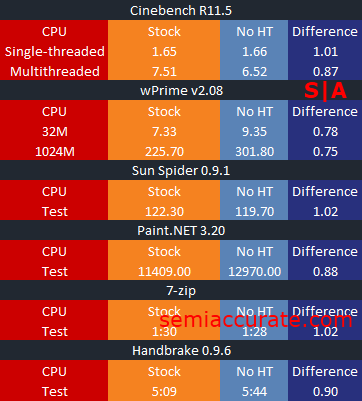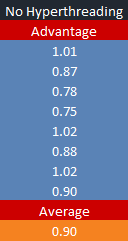Since Intel introduced its Hyper-Threading technology with its Pentium 4 microprocessors back in early 2002 reviewers have occasionally noticed that under certain conditions Hyper-Threading can actually hurt performance instead of helping it. A quick summary of this issue with Hyper-Threading can be found over at Bitsum.
We decided to explore the effects of Hyper-Threading on the performance of the Ivy Bridge based Core i7-3770K by running our CPU benchmarking suite on it twice. Once with Hyper-Threading enabled, and once with Hyper-Threading disabled. As such we set-up our results table to look for applications that perform better with Hyper-Threading disabled, rather than enabled.
As you can see there are a few applications that perform marginally better, to the tune of one to two percent, with Hyper-Threading disabled. But at the same time there is far more to be gained in terms of performance from leaving Hyper-Threading enabled than there is to be gained from disabling it.
On average the 3770K with Hyper-Threading disabled offers only 90 percent of the performance of the same chip with this feature enabled. Thus it stands to reason that leaving Hyper-Threading enabled is the best choice for consumers.
At this point I think it’s fair to say that the days of fear mongering over performance hits due to Hyper-Threading are well past their “best if used by” dates. The implementation of this technology found in Ivy Bridge processors, and to a large extent in Sandy Bridge processors, is quite robust and well adapted to our current crop of OS schedulers. Admittedly there will continue to be workloads that are I/O bound and thus poorly suited to the methods Hyper-Threading technology, but for the most part users don’t have any reason to worry about Hyper-Threading negatively affecting application performance. As performance enhancing technologies go, Hyper-Threading is surely one of the more mature examples that Intel has to offer.S|A
Updated: Monday April 30th 10:10 AM. Replaced image with corrected image per forum member notes.
Thomas Ryan
Latest posts by Thomas Ryan (see all)
- Intel’s Core i7-8700K: A Review - Oct 5, 2017
- Raijintek’s Thetis Window: A Case Review - Sep 28, 2017
- Intel’s Core i9-7980XE: A Review - Sep 25, 2017
- AMD’s Ryzen Pro and Ryzen Threadripper 1900X Come to Market - Aug 31, 2017
- Intel’s Core i9-7900X: A Review - Aug 24, 2017

